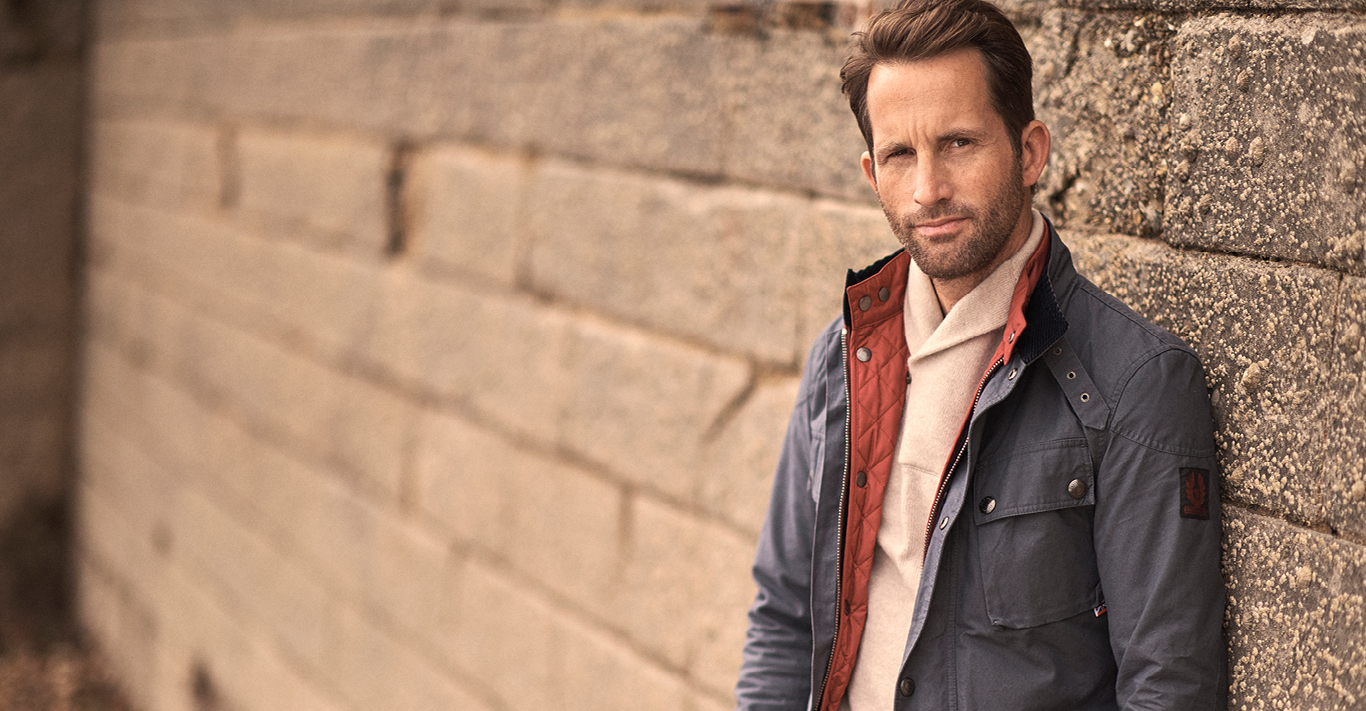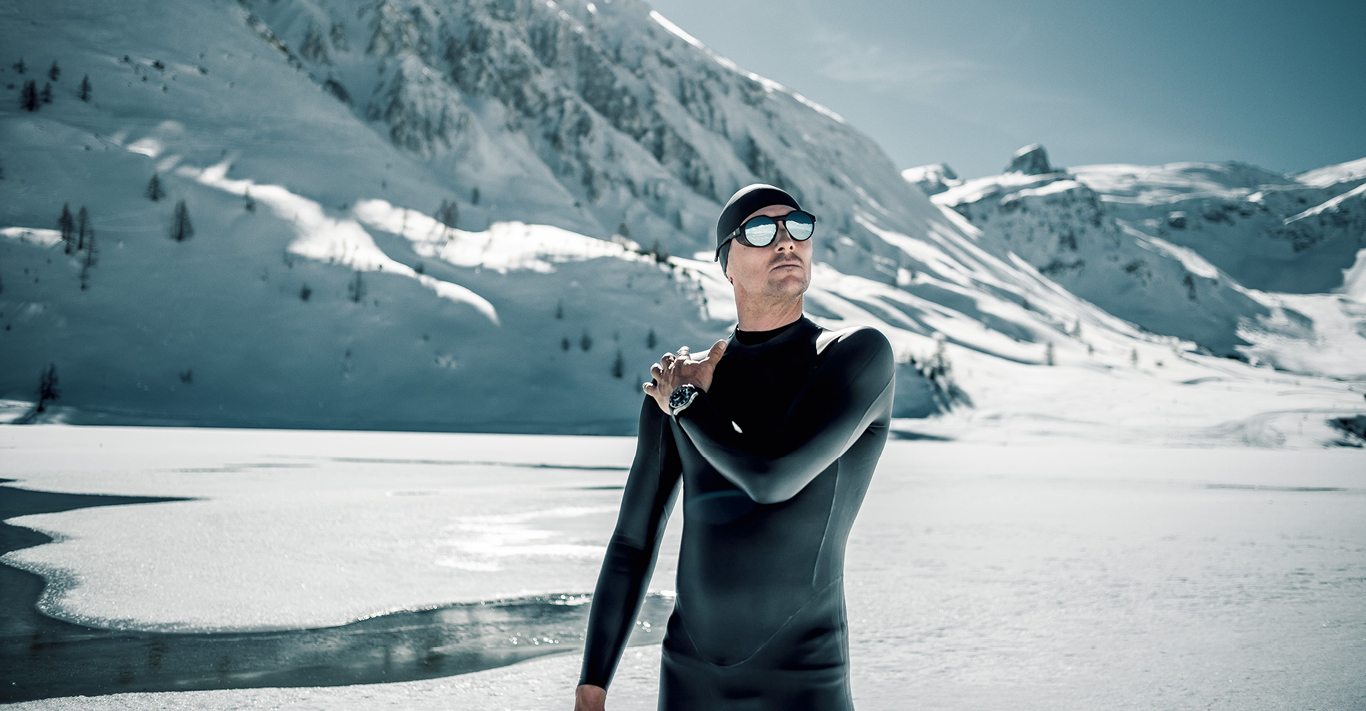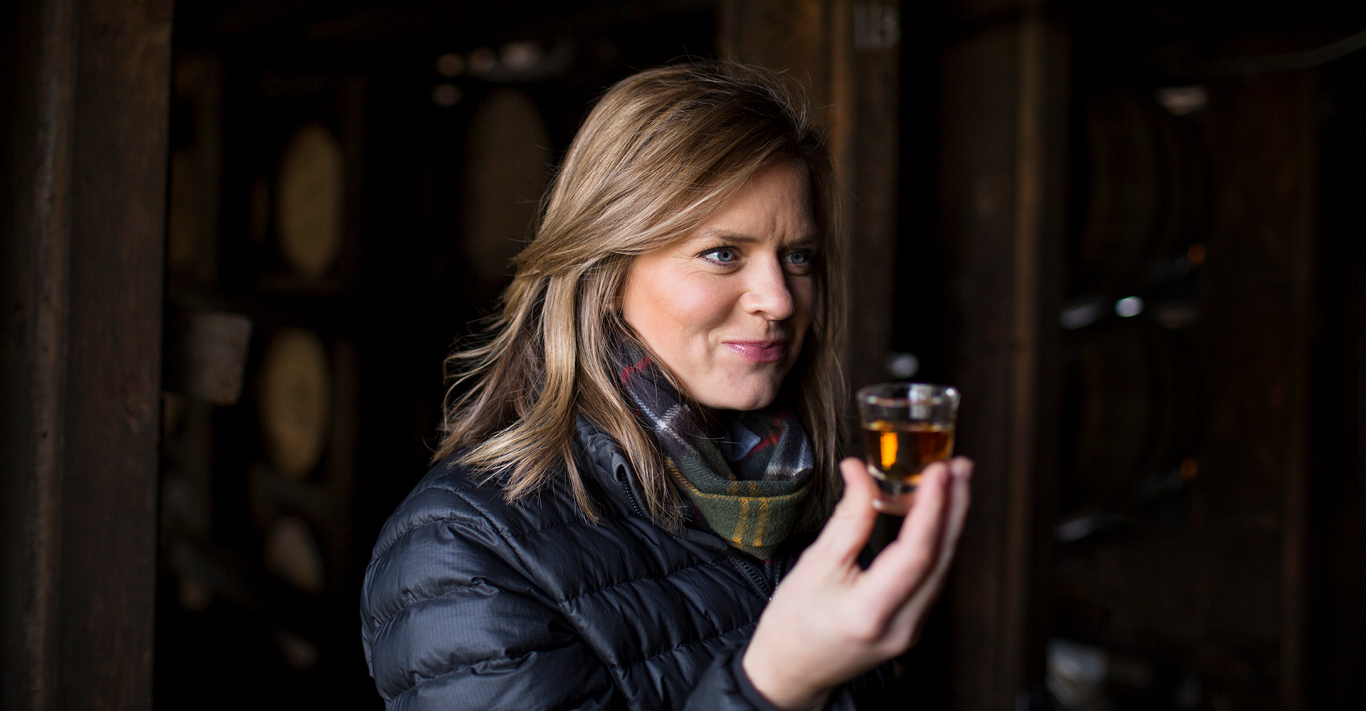WORDS
Peter Howarth
It may surprise those of you familiar with Belstaff that the firm, founded in Stoke-on-Trent in 1924 and so associated with motorcycling and waxed-cotton and leather jackets made for that purpose, also has a maritime connection. Although Belstaff’s long history has indeed seen it outfit generations of bikers, from Che Guevara to David Beckham, it has also been pressed into service by the military and has a special relationship with the Senior Service, for whom it has made both uniforms and protective gear. The Belstaff Foul Weather Parka was created for the Royal Navy in the 1970s, and during that decade, the firm created a range called Seamaster, which borrowed the graphic language of maritime kit.
More recently, a Belstaff technical sailing jacket from that era – the XL500 – was revived by creative director Sean Lehnhardt-Moore for this spring/summer’s collection. He explains how the oceans continue to inspire him. ‘Belstaff has always been for people who love the journey. From its very first days in the 1920s in the industrial north of England, when it outfitted early motorcyclists, aviators and adventurers, Belstaff has always made kit for those who love to travel and explore. The sea is, of course, part of that story – mysterious and alluring and elemental, and it has attracted those in search of adventure for centuries.’
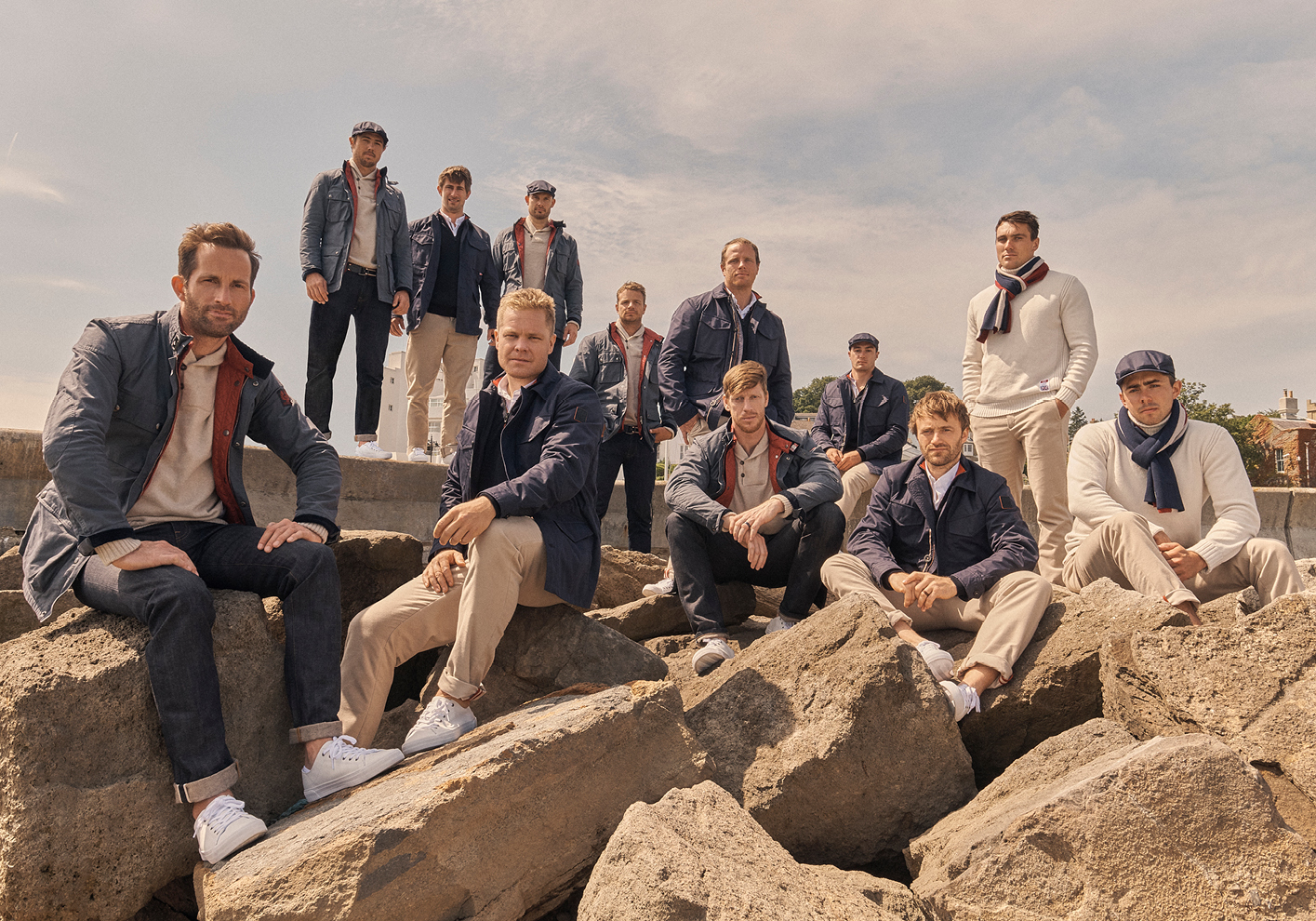
Given this, it is perhaps less surprising then that the latest notable person to don Belstaff is sailor Sir Ben Ainslie, winner of five Olympic medals and four World Sailor of the Year awards, and a man currently engaged in the biggest adventure of his life: the pursuit of the America’s Cup. Sir Ben is leading a team of 110 strong, including 16 sailors, in his quest to bring the trophy back to Great Britain for the first time in its history. The sailors have been outfitted by Belstaff in a new America’s Cup capsule collection, which is now being made available to the public.
Belstaff’s on-shore wardrobe for Ainslie’s Ineos Team UK takes its inspiration from the style of clothing worn by America’s Cup competitors in years past, particularly the elegant look of the 1950s. The 23-piece collection is based on well-established classic Belstaff pieces and features timeless silhouettes and high-performance materials that provide excellent durability. There is a new, lightweight dry wax version of the brand’s famous Trialmaster jacket, which means the patina changes as you wear it in, and the Portsmouth field jacket is a military-inspired design in high-performance materials. The Roding gilet is a channel-quilted, down-filled dark navy lightweight vest that is water-repellent and warm.
Cashmere/wool knits keep the look smart and there is also a selection of T-shirts, hoodies and caps. All the pieces incorporate the Ineos Team UK colours and logo, and Ainslie and crew were involved in providing information to Belstaff about their requirements that influenced the design. A consequence of this is that the items are functional, stylish and easy to wear, and, significantly, trans-seasonal, created to take the team through the different climates they would encounter in the build-up to the competition.
Ainslie says that he has had his eye on the America’s Cup – the oldest trophy in sport, which is known as the Auld Mug – ever since he first caught sight of some of the competition’s boats in the early 1980s. ‘I grew up in Cornwall, and I remember sailing in my dinghy one day and seeing these 12-metre yachts training in Falmouth harbour. I was awestruck by the power and grace of these boats, so I asked a friend’s father what are they, and he explained they were 12-metre-class America’s Cup vessels and what the competition was all about.’
Over the years, Ainslie became fascinated by this race. He read books about it, watched TV coverage and slowly, as his own competitive career as a sailor progressed, became passionate about being involved in the Cup and formed the ambition to win with a British team.
‘We’ve never won it. That’s the thing,’ he laughs. ‘In 170 years. If the British are quite good at inventing sports that we don’t win at, this has to be the best example. It started with a race round the Isle of Wight in 1851 against an American boat. Which won, renamed it the America’s Cup and sailed the trophy back to New York Harbour. Since then it’s been won by New Zealand, Australia, even Switzerland. But not by us. Which is a shame given our incredible proud maritime history.’
Ainslie, however, has won it. On an American boat, with Oracle Team USA. That victory followed two previous brushes with the trophy, once in 2001, on the back of his Olympic gold the previous year in a Laser class craft. Then he trained with another American boat but didn’t end up competing. However, in 2007, this time with New Zealand, he made it to the finals but narrowly lost to the Swiss Alinghi team. He particularly credits this stint with team New Zealand as being transformational: ‘That was a great learning experience, being in one of the top teams. They have a great work ethic and a great approach to life and sport; I learnt as a sailor and as a person.’
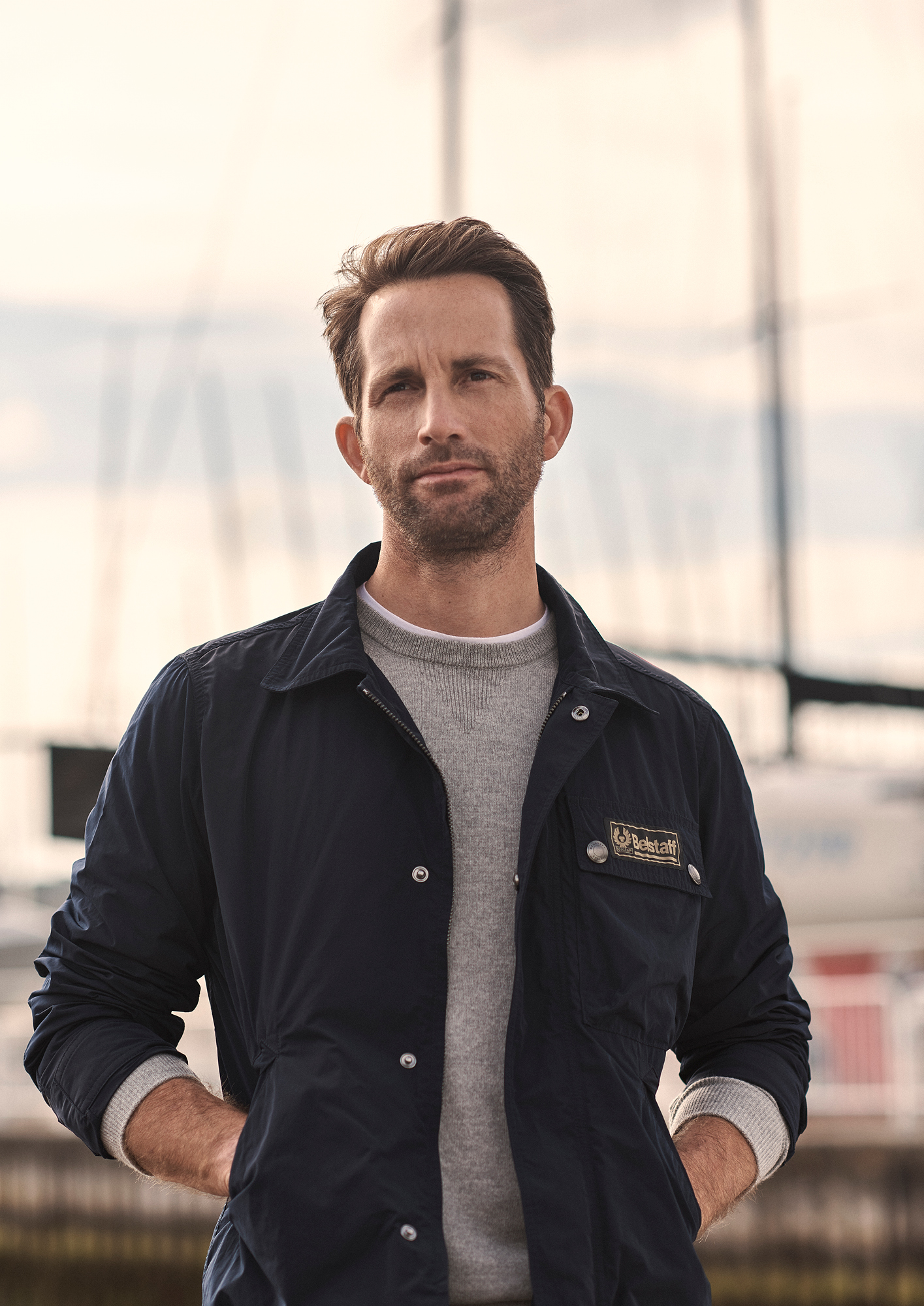
Which is ironic, because in 2013 he was brought on board by Oracle Team USA as the tactician to cope with the Kiwis, and famously helped take them from being 8-1 down in the final to win the Cup in San Francisco in what is widely considered to be one of the greatest sporting comebacks ever.
‘That was an incredible event to be a part of,’ remembers Ainslie. ‘And all my experience in the Cup has been amazing – to go from being a dinghy sailor to sailing a big powerful yacht… I enjoyed learning a completely new discipline of my sport, going from being an individual sailor, as I was, to being part of a big team.’
Already at that point, Ainslie was planning how he could lead a British boat to a successful challenge for the Auld Mug, and he got his first chance in 2017, when he led his crew to victory in the preliminary round, The America’s Cup World Series, where teams raced in identical boats. However, he found that he couldn’t convert that to a win in the final against his old colleagues and foes Team New Zealand when both teams were in their own-built boats.
The technology of the America’s Cup is an aspect of the race that cannot be underestimated. It is, according to Ainslie, one of three elements that make this competition so special: ‘You have the history, the prestige and the tech: the world’s oldest international sporting trophy, bags of prestige in terms of the teams and characters that have been involved over the years, and cutting-edge technology in naval architecture.’ It’s a powerful combination.
Where the boats are concerned, since 2013 these machines have been foiling rather than displacing water. In other words, they lift up out of the water on a hydrofoil and benefit from reduced drag. This means that whereas once the stately monohulled America’s Cup boats would manoeuvre at around 20 mph, now that can reach 60. At the last finals, the teams raced foiling catamarans; next year the AC75 boats are foiling monohulls.
‘Ostensibly, it’s the same sport, in that you’re dealing with the wind and the water and nature,’ explains Ainslie, adding, ‘but the sensation of being up on the water, out of the water, feels effortless. When you are going fast in a normal boat there’s spray everywhere. In the new boats, when you get to a certain speed, they lift up and there’s no wash. All you have is the wind noise – it’s like driving at 70 miles an hour on the motorway with the car windows down.’
The increased speed brings new challenges of course. ‘The speed of the boats – the handling of the boats – means everything happens that much faster,’ says Ainslie. ‘The work of the crew and the manoeuvring has to be spot on, as the penalty for making a bad manoeuvre is almost 10 times what it used to be; if you make a mistake you can lose 200 meters in a heartbeat. It’s true for the other team too of course; the relative gains and losses are much bigger than before. I suppose that’s what makes it so much more impressive from a televisual perspective – the race is never over until it is.’
Another consequence of the high level of technology now being employed is that it demands a different sort of sailor: part athlete, part technician. ‘In our world we are test pilots and we’re also race pilots. We have to give the right feedback to the designers and engineers about how the boat feels,’ explains Ainslie. ‘Design simulations and structural engineering might be cutting-edge but you need feedback from sailing the actual boat in real time. Then, when we get to the race we have to perform and manoeuvre well; we have to be properly practised and drilled right.’
As skipper, much of the responsibility for that performance falls to Ainslie. He says that the tactics are similar to those he might employ alone in an Olympic boat, but the difference is the speed at which he has to operate. ‘The speed is key. You have to be much more accurate and delicate about how you steer the boat. There’s a narrow window of performance. Obviously, you’ve got to be brave, handling a 75-foot boat pulling through the water at over 60 miles an hour.’
And unlike the Olympics, it’s not just down to you. So what makes a good captain? “You’ve got to lead by example and have the right work ethic,’ he says. ‘You’ve got to be understanding of other people’s situations; I learnt the hard way in my career that it’s no good shouting at people when things go wrong. You have to understand why, help people get better, get the team better – understand weak areas and help everyone improve.’ So add psychologist to the job description. ‘It’s been an interesting learning experience: how to work with people and get the best out of them. How to strike the right balance between pushing them to the max but not over their limit.’
Preparations for the competition are going well, he says. The team is about to decamp to New Zealand from its HQ in Portsmouth. ‘The whole world has had a difficult time with Covid,’ he acknowledges, ‘and that’s slowed us down, considerably, but also slowed down our competitors.’ The team was training in Sardinia at the time of the outbreak and had to relocate to the UK. ‘It took time out of our training and testing time. We changed our working practices and haven’t had a case [of Covid-19] in the organisation to date. The team is now on target. And the construction of our second boat – our race boat – is on target. And that is the biggest target.’
Throughout the preparations in a rapidly changing world, one constant for Ainslie’s team has been that it has been kitted out in the Belstaff America’s Cup Collection. But this was not the sailor’s first encounter with the British label. He was already a wearer before the partnership. ‘My wife actually introduced me to Belstaff. For Christmas, she bought me a lovely jacket. Six months later I met Sir Jim Ratcliff, and I had no idea he had any connection with Belstaff – it was bizarre.’
Ratcliff is the Chairman and CEO of INEOS, the multinational chemicals company that he founded and that is sponsoring Ainslie’s British boat, which sails under the name INEOS Team UK. He is a sports fan who also owns the Ineos Grenadiers, the cycling team that was formerly the seven-times Tour de France-winning Team Sky. When Ainslie met Ratcliff for a drink, it turned out to be one of the most expensive in history, with the businessman agreeing to fund the British bid to win the 35th America’s Cup in March 2021. Ratcliff has joked that what started out as a gin and tonic ended up costing him considerably more than £100 million.
Coincidentally, Ratcliff, a keen motorcyclist, also owns Belstaff through Ineos. Hence the new Belstaff America’s Cup Collection, which Ainslie and his teammates have been trialling for months now. ‘We don’t wear Belstaff on the water, of course, because we race in highly technical gear. But its clothing is actually very technical, too. The Trialmaster jacket, for example, is a fantastic protective outdoor jacket that looks incredible as well.’ He says that the team is also very aware of the history of the brand. ‘It actually encompasses what this partnership for the America’s Cup is all about. It has a history with all the amazing people who have worn it over the years, and now we are taking on that mantle with our own particular challenge as a pioneering, British team.’
Ainslie says his favourites are the sneakers they have been issued with (‘they are exceptionally comfortable – you never find a pair of shoes that just fit your feet’) and the Journey jacket. ‘Belstaff jackets are amazing. The Trialmaster is, of course, well known and I love it, but in this collection there is the Journey jacket. It’s my favourite – it’s so cool and has so much character; it looks like it’s been all over the world and done so many things and has so many stories.’
It is ultimately the sense of the adventure inherent in Belstaff that seems to resonate with this sailor and athlete. ‘We’re all very proud of the prestige and heritage of Belstaff,’ says Ainslie. ‘The brand is a good fit with our pioneering approach to life – it’s what we’re all about.’
And he ends by explaining what that pioneering approach means for him. ‘It’s all about freedom. I still remember the first time I went sailing on my own. I learnt how to sail with my family in Cornwall, which is a fantastic place to grow up if you want access to the water, but the first time on my own was really special. I was in an Optimist dinghy, a little 10-foot dinghy that looks a bit like a bathtub – but you can sail round the world in it. I was eight or nine years old and my dad sent me off from a beach where we lived. What struck me was that sense of freedom. As a kid, being away from your parents, away from adults and siblings telling you what to do, on your own, in control. It was an amazing feeling. The sensation of water rippling up the hull of the boat – I still remember that precise moment to this day.’
He pauses. ‘Then it gets a bit bigger, a bit faster and a bit more expensive. But that sensation is what it is always all about. It never changes.’
The 36th America’s Cup will take place in Waitemata Harbour, Auckland, New Zealand, from Saturday 6 March to Sunday 21 March 2021; belstaff.co.uk


